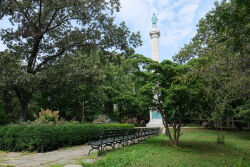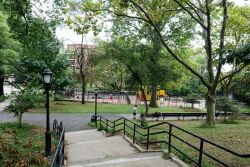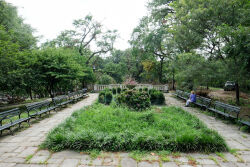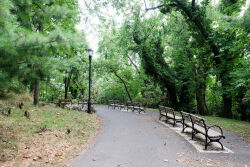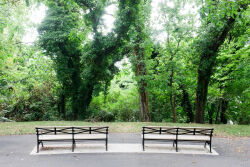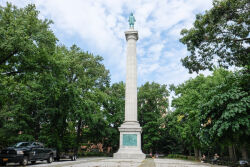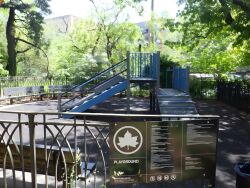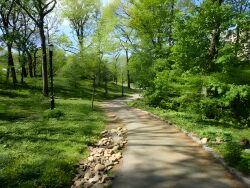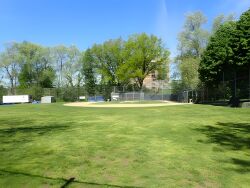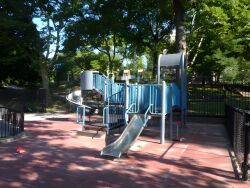Henry Hudson Park
Henry Hudson Park
What was here before?
This once-wooded bluff was home to Native Americans, and its commanding views up and down river served as an advantageous lookout. Europeans later settled in Spuyten Duyvil, and burgeoning iron foundries along the river’s edge and the opening of the Hudson River Railroad in the mid-19th century spurred the community’s growth. Just north of today’s park was one of eight military fortifications built by the colonists during the Revolutionary War and dubbed Old Fort #1 by the British who garrisoned Hessian soldiers there. The site was later the estate of William C. Muschenheim, proprietor of the Hotel Astor, which boasted a lavish floral garden known as Nipnichsen Terrace. The Samuel and Dorcas Berrian homestead stood in what is the park’s southern precinct, now occupied by athletic fields, and the most level ground, situated on the estate of local foundry owner David B. Cox, was used by a local baseball club for matches as early as the 1860s.
How did this site become a park?
In 1906, civic leaders organized the Hudson-Fulton Celebration to mark the 300th anniversary of the arrival of Henry Hudson and the Dutch ship the Halve Maen (Half Moon) and the 100th anniversary of the maiden voyage of Robert Fulton’s North River Steamboat. They planned a monument to Hudson on this promontory and a bridge that would link Inwood in Manhattan with Spuyten Duyvil.
The committee broke ground at the donated memorial site in 1909, and the massive Doric column was erected in 1912, though Karl Bitter’s plaster model of Henry Hudson remained unfinished due to lack of funds. Between 1906 and 1909 land for the Bronx approach to the future bridge was condemned for public use, including the acquisition of the L-shaped property of the upper park.
In the 1930s, Parks Commissioner and public “power broker” Robert Moses sought to transform the secluded corner of the Bronx into a key hub in a regional network of parkways, bridges, and parks. The Parks Department acquired the site of the unbuilt bridge approach and additional land between 1935 and 1937. The entire site was named Henry Hudson Memorial Park and improved with landscaping, paths, benches, iron fences, and a playground.
Between 1936 and 1938 the parkway was completed, and the upper level of the Henry Hudson Bridge was opened to traffic. Sculptor Karl H. Gruppe, a student of Bitter, redesigned the bronze figure of Hudson and the two bas-reliefs at the base of the column, and the completed Henry Hudson Memorial was dedicated on January 6, 1938.
Several capital projects from 1989 to 2018 upgraded the playground, basketball and handball courts, improved paths and stairways, renovated the ballfields, and restored the monument and monument plaza.
Who is this park named for?
This hillside has gone by many names over time—Nipnichsen, Berrian’s Neck, Spuyten Duyvil Hill—and the broader neighborhood known as Riverdale. The park is named for Henry Hudson (1575-1611) an English explorer and navigator. In September 1609 Hudson, then captain of the Half Moon, dropped anchor in the lower bay of what is now New York Harbor. Hudson had been hired by the Dutch East India Company to find a sea route through North America to the Far East. The ship sailed up the river that now bears his name, docking off Spuyten Duyvil and attempting travel even further upstream before abandoning the quest, realizing that the river was narrowing. Hudson’s last voyage was in 1611 when after claiming for England the body of water in Canada later named Hudson’s Bay, and pressing for further westward exploration, he was cast adrift by his mutinying crew. In the 1620s, the Dutch established a trading post in lower Manhattan that would become New Netherland.
Check out your park's Vital Signs
Clean & Safe
Green & Resilient
Empowered & Engaged Users
Share your feedback or learn more about how this park is part of a
Vital Park System

